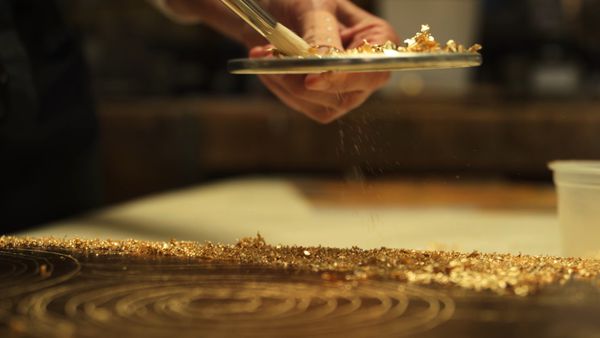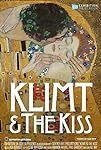Eye For Film >> Movies >> Klimt & The Kiss (2023) Film Review
Klimt & The Kiss
Reviewed by: Jennie Kermode

When a painting becomes as famous as Gustav Klimt’s The Kiss, a kind of populist appropriation can take place which dissuades those with a serious interest in art from taking it seriously. One participant in Ali Ray’s documentary suggests that students have posters of it on their walls because of its beauty, or because they think it’s romantic. This may be doing some of them a disservice. It’s isn’t all that difficult to observe that there’s something off about the embrace that it depicts. The man’s hands are on the woman’s throat; she appears to be trying to prise them off. This is the ambiguity which really cements the picture’s power and has intrigued scholars and members of the public alike ever since its first exhibition in 1908.
Centring on an exhibition which places Klimt’s works alongside those of his contemporaries, the latest entry in the Exhibition On Screen series is relatively light in its exploration of that mystery – after all, only so much is known – but fascinating in its analysis of other aspects of the painting. It also addresses the life of the artist and explores the development of his work, including the techniques and themes which would eventually coalesce in The Kiss. A foreshadowing of the work can be seen when we see Klimt’s Beethoven frieze, culminating in his interpretation of the Ode To Joy. The sun smiling over the male figure and the sleeping moon above the female one are not innovations but they point up the gender codes which we will see echoed again and again in other paintings.

As in previous instalments of the series, we are given the privileged access to the artworks that only a camera can provide. Close-ups let us examine details in a way impossible for a visitor to a crowded gallery, and we also have the chance to see x-rays which reveal the underlying creative process layer by layer. There’s a demonstration of the method used to create that shimmering background, with primer, glue, shellac, brass leaf, dark brown resin, oil glaze, and gold and silver flake blown into place through a bamboo tube – the Urushi technique. The depth and complexity of the piece becomes more apparent than ever, even when we are reminded of its modern context by a display of associated tat.
Other works which get particular attention include Klimt’s majestic Athena Pallas, with goddess in her splendid golden helmet holding the figure of Nuda Veritas; his portrait of Sonja Knips in her fairy tale pink gown with an unexplained monster lurking in the shadows behind her; the Water Serpents pieces with their hints of lesbianism, which was illegal in Austria at the time; Judith And The Head Of Holofernes, a rare case of him taking an interest in a woman’s personality; and Death And Life, bearing the shadow of the Great War and presaging the stroke which would lead to his own demise. There is also a glimpse of unfinished work The Bride, intriguing in what it illustrates about his way of working.
Klimt’s influences were numerous and widespread. It would be impossible to do them all justice here (there is quite enough material for a series), but Ray does her best. As well as highlighting the more obvious ones – Medieval art, the Byzantine, the Japanese lacquer work – she addresses his position within a wider Avant Garde movement which included the likes of Margaret Macdonald Mackintosh (a woman too often lost in her husband’s shadow), considers his take on Art Nouveau, and also looks at what he owed to the impressionists. To see his Poppy Field and Monet’s side by side makes quite an impact, and may persuade you to focus with renewed interest on the flowers in The Kiss, the meadow in which Ariadne lay sleeping, the botanical motifs which give her form as she struggles in Dionysus’ embrace.
Equally relevant, and less often seen, is the early monochrome work Philosophy which, the film conjectures, emerged when he was suffering a crisis subsequent to his success in gaining wealth by pleasing the bourgeoisie. What seems most striking about this moment in his life is that his early success brought him to it much earlier than was the case for other artists (when they were lucky enough to reach it at all), so that he spent decades able to focus primarily on pursuing his own inspirations, developing, in the process, a highly distinctive (if somewhat referential) vision. The many women whose lives were sacrificed to this, one way or another, along the way, are referenced with sympathy even when their names are not know. Photographs depict the secret moments he shared with his muse, Emilie Flöge, though Ali makes no claim as to the natures of their intimacies. We see garments she designed in his portraits of other women, her art finding immortality through his.
There is a great deal more to enjoy here, from a tour of the architectural marvels being created in Vienna at the time (some of them containing stunning frescos which he contributed to), to reflections on his satirical works and his later allegorical portraiture. We see some of the drawings which first revealed his talent as a young student – quite remarkable in what they reveal about his knowledge of anatomy – and hear about the accusations of pornography which he faced.
What emerges at every turn is the degree to which he made his own choices, even to the point where he seemed to be conscious of his role in exploiting a hierarchical system in which women were widely perceived as two dimensional. In his paintings, flat and pale, often somnolent, they become beautiful objects – yet it is impossible to behold them, framed as they are, and not wonder about their stories. The Kiss was never just a kiss.
Reviewed on: 29 Oct 2023
















